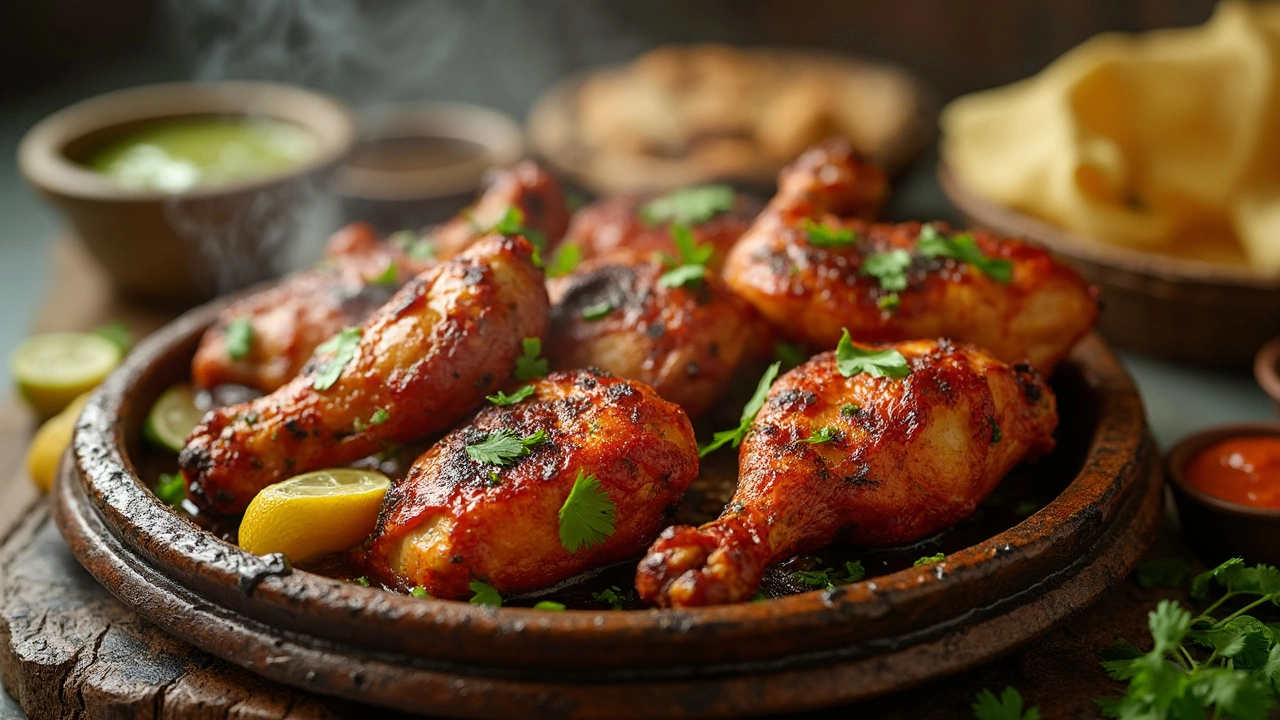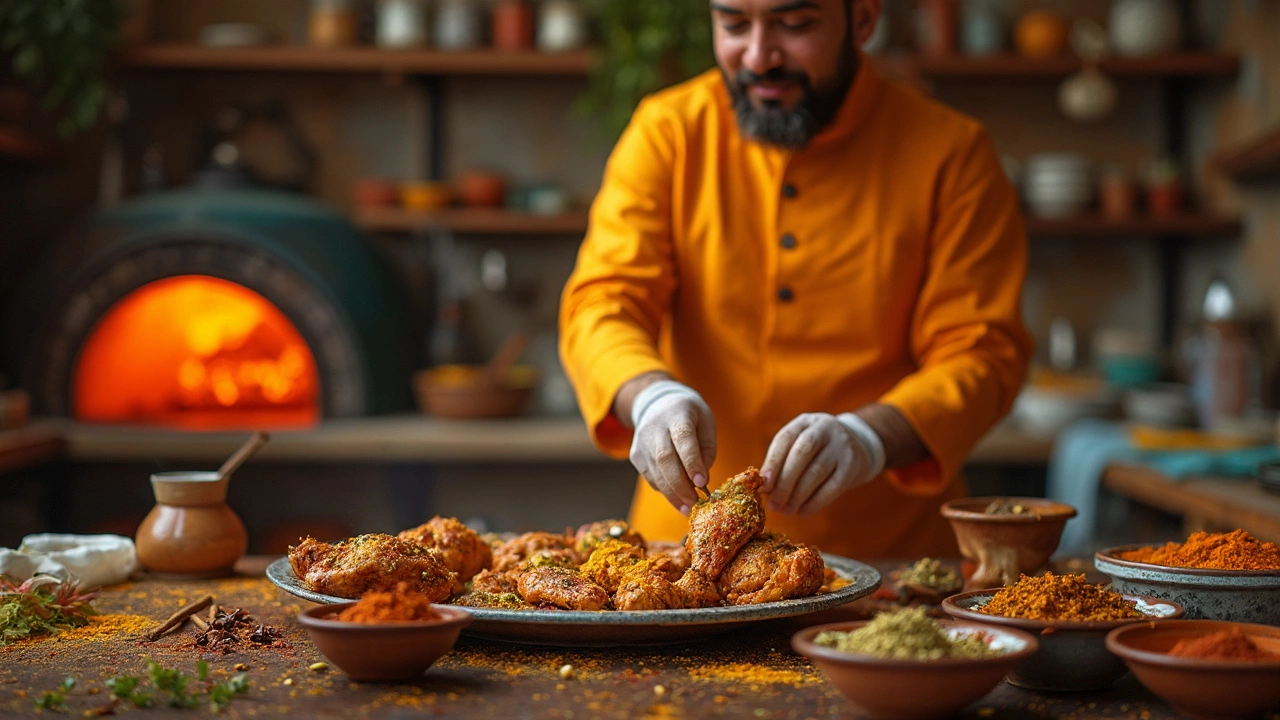2 Mar 2025
- 0 Comments
Messed up a batch of tandoori chicken, have you? Don’t worry, you’re not alone! The haunting question of 'Why is my tandoori chicken so dry?' has puzzled many a home chef. But fear not, we’re here to untangle this mystery.
First off, let’s chat about what's probably going wrong. Overenthusiastic skimping on marinade time? Or perhaps you've cranked up the oven heat way too high? These are common mistakes that leave folks with dry, chewy chicken rather than the juicy delight they hoped for.
So, what’s the trick for ensuring a succulent dish? It boils down to a few essentials – proper marination, the right cooking temperature, and timing. Let's dig deeper into how even small tweaks can make a big difference.
- Common Missteps with Tandoori Chicken
- Understanding Marinades and Moisture
- Cooking Techniques That Matter
- Tips for the Perfect Juicy Tandoori Chicken
Common Missteps with Tandoori Chicken
Making tandoori chicken sounds easy, right? Marinade, cook, and voila! But let’s face it, things can go sideways quickly if we’re not careful. So, what are the usual culprits that make this dish dry?
Skipping Proper Marination
Skipping or rushing through the marination process is like skipping the trailers at the movies—you're quick to the main feature but miss the build-up. The longer you let the chicken marinate, the better it infuses with flavors. Ideally, aim for at least 6-8 hours in the fridge.
Wrong Yogurt Choice
Another sneaky mistake is using the wrong type of yogurt. Thick Greek yogurt is your best friend here. It sticks to the chicken better and helps tenderize the meat, making your tandoori chicken juicy instead of dry.
Getting the Heat Wrong
High heat can be a killer—literally drying the chicken to oblivion. It’s all about balance. Cook at a steady 180-200°C. Too hot and it dries; too cold and it stays raw. Not what we’re aiming for!
Inconsistent Chicken Sizes
If you’re throwing uneven chicken pieces into the mix, expect different cooking times. Keep your pieces uniformly sized so they cook at the same rate and prevent dryness.
Not Preheating Your Oven or Grill
Diving in without preheating? Big no-no! It’s like sticking a pizza in a cold oven—it just doesn’t work. Preheat your oven or grill to the right temperature to ensure the tandoori chicken cooks evenly straight away.
Lack of Oil
Skipping the oil in your marinade isn’t a great move either. A bit of oil not only locks in the moisture but also helps achieve that beautiful char.
Understanding Marinades and Moisture
Alright, let's dive into the nitty-gritty of marinades and why they're the backbone of great tandoori chicken. The marinade isn’t just about flavor; it’s crucial for moisture too. It typically consists of yogurt, lemon juice, and a variety of spices that work together to tenderize and infuse flavor.
The Role of Yogurt
Yogurt isn’t just about creamy texture. Its slight acidity breaks down protein fibers, making the chicken tender. The naturally occurring lactic acid in yogurt helps retain moisture during cooking, so ditching this ingredient? Not a great idea if you're aiming for juicy results.
Spices and Their Magic
Next up, the spices! It's not just about heat. Ingredients like turmeric, cumin, and garam masala do more than add color and flavor—they’re part of an ancient tradition ensuring the meat stays deliciously moist. Spices create a thin film on the chicken surface that locks in moisture as it cooks.
Marination Time Matters
Don’t rush it! Ideally, your chicken should bathe in the marinade for at least 6 to 8 hours. The more time the chicken absorbs the seasoning, the more flavorful and tender it’ll become. Short on time? Aim for at least 2 hours, though overnight marination is your best bet.
Avoiding Dryness
- Don't omit yogurt unless you have a substitute. Coconut milk could work, but it won't tenderize as well.
- Avoid over-marinating. Yes, marinating too long, especially with acidic ingredients, can lead to mushy texture.
- Balance salt correctly; too little and your flavors are flat, too much and it draws moisture out.
Get these right, and you’re in for some mouth-watering, perfectly moist tandoori chicken every time.

Cooking Techniques That Matter
When it comes to cooking real deal tandoori chicken, ignoring the right techniques can leave you with a dry mess on your plate. It's all about perfecting the method to ensure that your chicken stays juicy and packed with flavor.
Setting the Right Temperature
The first step is getting your temperature right. You want to cook the chicken at around 200°C (about 392°F). This might vary depending on your oven, so a meat thermometer can be your best friend. You're aiming for an internal temperature of around 75°C (167°F) to kill bacteria without sucking all the moisture out.
Expert chef, Priya Gupta, nails it when she says, "
Cook it too hot, and you’ll rob tandoori chicken of its essence - that wonderful, juicy perfection." Hence, sticking to the recommended temperature is essential for achieving the best results.
Knowing When to Flip
Flipping your chicken at the right moment is crucial. About halfway through the cooking time, flip each piece to ensure even cooking and that beautiful char we all love. No need to fuss over constantly turning; twice during cooking is plenty.
Rest Your Chicken
Once out of the oven, let your tandoori chicken rest for about 5 minutes. This waiting time allows the juices to redistribute, giving you tender pieces instead of a dry meal. Plus, it’s always good advice to let folks build a little more anticipation before digging in!
Basting for Extra Moisture
Giving your chicken a quick baste with melted butter midway through cooking can work wonders. It not only adds flavor but helps the chicken retain moisture.
With these techniques, cooking tandoori chicken like a pro is within reach! Remember, it's all in the simple things: the right temperature, perfect timing, and letting the chicken rest. These methods ensure each bite is succulent and flavorful, leaving dryness behind.
Tips for the Perfect Juicy Tandoori Chicken
Let's get down to business and turn your tandoori chicken dreams into reality. Keeping the chicken juicy isn't about magic. It's about simple science and a bit of patience. Here are some fool-proof tactics to ensure your next venture into tandoori chicken territory is a smashing success.
1. Marinate Like a Pro
The marinade isn't just about flavor; it's also about keeping that chicken moist. Go for a yogurt-based marinade. Why yogurt? It's packed with lactic acid, which not only tenderizes the meat but also locks in moisture.
- Use full-fat yogurt to keep things rich and delicious.
- Add lemon juice or vinegar for tanginess, but don’t overdo it to avoid cooking the chicken with the acid.
- Let the chicken soak for at least 6 hours, but overnight is even better. Patience, my friend!
2. Mind the Cook Time
Cooking chicken for too long on high heat is a no-go if you want it tender. Instead, cook it just until it's done. Take a look at this guideline for ideal cooking:
| Weight | Suggested Cooking Time |
|---|---|
| 500g | 25 - 30 mins at 180°C (350°F) |
Always preheat your oven or grill. Starting with a hot surface helps seal in the juices!
3. Let It Rest
Resting your chicken after it’s off the heat is a step you shouldn't skip. Giving it 5-10 minutes allows the juices to redistribute evenly. So, no eager slicing right off the grill!
4. Baste to Keep It Moist
Basting isn’t just for the Thanksgiving turkey. Brush your chicken with a mixture of oil, lemon juice, and leftover marinade halfway through cooking. This adds layers of flavor while keeping it moist.
By following these recipe tips, you're bound to have juicy tandoori chicken that's not only a treat for the taste buds but also makes your cooking prowess the talk of the town.
